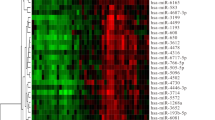Abstract
Purpose
Different levels of miRNA expression have been described in salivary gland tumors as a potential diagnostic marker and predictor of survival. We systematically reviewed the literature to assess the diagnostic and prognostic value of miRNAs on salivary gland tumors.
Methods
An electronic search was conducted in PubMed, Scopus, Embase, Cochrane, and Web of Science databases. In the meta-analysis, we assumed random-effects model with adjusted hazard ratio (HR) and 95% confidence intervals (95% CI). For prognostic studies, the risk of bias was assessed by Meta-Analysis of Statistics Assessment and Review Instrument (MAStARI) and Quality Assessment Tool for Diagnostic Accuracy Studies-2 (QUADAS-2) was utilized for diagnostic studies.
Results
Gathered data from 1.131 patients in seven studies demonstrated that different levels of miRNA expression presented diagnostic and prognostic in SGTs. The meta-analysis showed that altered miRNA expression were associated with shortened survival (HR, 2.35, 95% CI, 1.77–3.10, P < .00001). For diagnostic meta-analysis, the overall pooled results for specificity and sensibility were 0.87–0.97 (95% CI, 0.72–1) and 0.68–0.91 (95% CI, 0.51–0.96), respectively.
Conclusion
MicroRNAs may be useful in prognostication of patients with SGTs; however, the diagnostic value of miRNAs in SGTs is still limited.




Similar content being viewed by others
References
Seethala RR, Stenman G (2017) Update from the 4th edition of the World Health Organization classification of head and neck tumours: tumors of the salivary gland. Head Neck Pathol 11:55–67
Fonseca FP, Carvalho MV, Almeida OP, Rangel AL, Takizawa MC, Bueno AG et al (2012) Clinicopathologic analysis of 493 cases of salivary gland tumors in a Southern Brazilian population. Oral Surg Oral Med Oral Pathol Oral Radiol 114:230–239
El-Naggar AK, Chan JKC, Grandis JK, Takata T, Sootweg PJ (2017) Classification of head and neck pathology tumours. 4th ed. IARC, Lyon, p 159
Wirapati P, Sotiriou C, Kunkel S, Farmer P, Pradervand S, Haibe-Kains B, et al. (2008) Meta-analysis of gene expression profiles in breast cancer: toward a unified understanding of breast cancer subtyping and prognosis signatures. Breast Cancer Res 1-11
Matse JH, Yoshizawa J, Wang X, Elashoff D, Bolscher JG, Veerman EC et al (2015) Human salivary micro-RNA in patients with parotid salivary gland neoplasms. PLoS One 10:e0142264
Andreasen S, Agander TK, Bjørndal K, Erentaite D, Heegaard S, Larsen SR et al (2018) Genetic rearrangements, hotspot mutations, and microRNA expression in the progression of metastatic adenoid cystic carcinoma of the salivary gland. Oncotarget 13:19675–19687
Almeida MI, Reis RM, Calin GA (2011) MicroRNA history: discovery, recent applications, and next frontiers. Mutat Res 717:1–8
Mitani Y, Roberts DB, Fatani H, Weber RS, Kies MS, Lippman SM, el-Naggar AK (2013) MicroRNA profiling of salivary adenoid cystic carcinoma: association of miR-17-92 upregulation with poor outcome. PLoS One 8:e66778
Santos PRB, Coutinho-Camillo CM, Soares FA, Freitas VS, Vilas-Bôas DS, Xavier FCA, Rocha CAG, de Araújo IB, dos Santos JN (2017) MicroRNAs expression pattern related to mast cell activation and angiogenesis in paraffin-embedded salivary gland tumors. Pathol Res Pract 213:1470–1476
Moher D, Liberati A, Tetzlaff J, Altman DG, PRISMA Group (2010) Preferred reporting items for systematic reviews and meta-analyses: the PRISMA statement. Int J Surg 8:336–341
Ouzzani M, Hammady H, Fedorowicz Z, Elmagarmid A (2016) Rayyan—a web and mobile app for systematic reviews. Syst Rev 5:210
The JBI (2014) MAStARI: Joanna Briggs Institute Reviewer's Manual 2014. Joanna Briggs Institute: University of Adelaide
Whiting PF, Rutjes AW, Westwood ME, Mallett S, Deeks JJ, Reitsma JB et al (2011) QUADAS-2: a revised tool for the quality assessment of diagnostic accuracy studies. Ann Intern Med 18:529–536
Deeks JJ, Bossuyt PM, Gatsonis C (editors) (2010) Cochrane handbook for systematic reviews of diagnostic test accuracy Version 1.0. The Cochrane collaboration
Balshem H, Helfand M, Schünemann HJ, Oxman AD, Kunz R, Brozek J, Vist GE, Falck-Ytter Y, Meerpohl J, Norris S, Guyatt GH (2011) GRADE guidelines: 3. Rating the quality of evidence. J Clin Epidemiol 64:401–406
Sun JY, Huang Y, Li JP, Zhang X, Wang L, Meng YL, Yan B, Bian YQ, Zhao J, Wang WZ, Yang AG, Zhang R (2012) MicroRNA-320a suppresses human colon cancer cell proliferation by directly targeting beta-catenin. Biochem Biophys Res Commun 420:787–792
Liang Y, Ye J, Jiao J, Zhang J, Lu Y, Zhang L, Wan D, Duan L, Wu Y, Zhang B (2017) Downregulation of miR-125a-5p is associated with salivary adenoid cystic carcinoma progression via targeting p38/JNK/ERK signal pathway. Am J Transl Res 9:1101–1113
Matse JH, Yoshizawa J, Wang X, Elashoff D, Bolscher JG, Veerman EC et al (2013) Discovery and prevalidation of salivary extracellular microRNA biomarkers panel for the noninvasive detection of benign and malignant parotid gland tumors. Clin Cancer Res 19:3032–3038
Boštjančič E, Hauptman N, Grošelj A, Glavač D, Volavšek M (2017) Expression, mutation, and amplification status of EGFR and its correlation with five miRNAs in salivary gland tumours. Biomed Res Int 2017:9150402
Andreasen S, Tan Q, Agander TK, Hansen TVO, Steiner P, Bjørndal K, Høgdall E, Larsen SR, Erentaite D, Olsen CH, Ulhøi BP, Heegaard S, Wessel I, Homøe P (2018) MicroRNA dysregulation in adenoid cystic carcinoma of the salivary gland in relation to prognosis and gene fusion status: a cohort study. Virchows Arch 473:329–340
Ravegnini G, Cargnin S, Sammarini G, Zanotti F, Bermejo JL, Hrelia P, Terrazzino S, Angelini S (2019) Prognostic role of miR-221 and miR-222 expression in cancer patients: a systematic review and meta-analysis. Cancers (Basel) 11:970
Schmidt RL, Hall BJ, Wilson AR, Layfield LJ (2011) A systematic review and meta-analysis of the diagnostic accuracy of fine-needle aspiration cytology for parotid gland lesions. Am J Clin Pathol 136:45–59
Carnielli CM, Macedo CCS, De Rossi T et al (2018) Combining discovery and targeted proteomics reveals a prognostic signature in oral cancer. Nat Commun 9(1):3598. Published 2018 Sep 5
Hocwald E, Korkmaz H, Yoo GH, Adsay V, Shibuya TY, Abrams J, Jacobs JR (2001) Prognostic factors in major salivary gland cancer. Laryngoscope 111:1434–1439
Zang J, Li C, Zhao LN, Shi M, Zhou YC, Wang JH, Li X (2013) Prognostic value of vascular endothelial growth factor in patients with head and neck cancer: a meta-analysis. Head Neck 35:1507–1514
Schaar DG, Medina DJ, Moore DF, Strair RK, Ting Y (2009) miR-320 targets transferrin receptor 1 (CD71) and inhibits cell proliferation. Exp Hematol 37:245–255
Zhang Y, He X, Liu Y, Ye Y, Zhang H, He P et al (2012) microRNA-320a inhibits tumor invasion by targeting neuropilin 1 and is associated with liver metastasis in colorectal cancer. Oncol Rep 27:685–694
Acknowledgements
ESS was supported by the São Paulo Research Foundation (FAPESP) under the grant 2018/19922-9. AGCN is supported by the São Paulo ResearchFoundation (FAPESP) under the grant FAPESP 2019/09692-9. JFS is supported by the São Paulo Research Foundation (FAPESP) under the grant FAPESP2019/09419-0. RALS was supported by the São Paulo Research Foundation (FAPESP) under the grant 2019/06809-2. Adriana Franco Paes Leme is a researcher fellow funded by the Brazilian NationalCouncil for Scientific and Technological Development (CNPq).
Author information
Authors and Affiliations
Contributions
ESS contributed to conception, design, data acquisition and interpretation, quality control of data and algorithms, drafted, statistical analysis, and critically revised the manuscript. AGCN, JFS, LCR, RALS, FVM, and AFPL contributed to data acquisition and interpretation, statistical analysis, manuscript editing and critically revised the manuscript. FVM and AFPL are supervisors of this work. All authors gave their final approval and agreed to be accountable for all aspects of the work.
Corresponding author
Ethics declarations
Ethical approval
Not applicable
Consent to participate
Not applicable
Conflict of interest
The authors declare no competing interests.
Additional information
Publisher’s note
Springer Nature remains neutral with regard to jurisdictional claims in published maps and institutional affiliations.
Rights and permissions
About this article
Cite this article
Dos Santos, E.S., Normando, A.G.C., Scarini, J.F. et al. Diagnostic and prognostic value of miRNAs on salivary gland tumors: a systematic review and meta-analysis. Oral Maxillofac Surg 25, 445–456 (2021). https://doi.org/10.1007/s10006-021-00952-0
Received:
Accepted:
Published:
Issue Date:
DOI: https://doi.org/10.1007/s10006-021-00952-0




